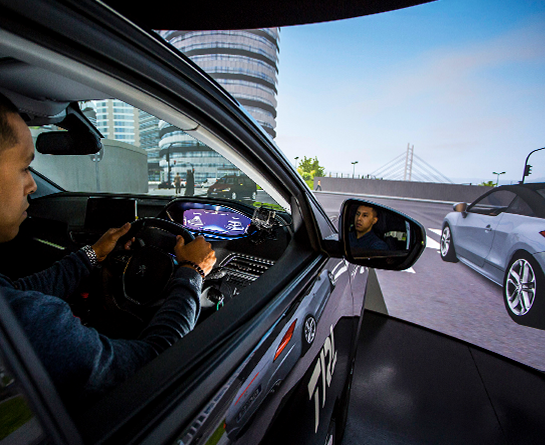TRL and driving simulation
TRL has a long history of simulating the driving experience. In the late 1970s one of our first driving simulators was a reasonably rudimentary (yet innovative for its time) rig, consisting of a vehicle cabin positioned in front of a projector screen displaying moving images of road scenes.Later in the 1980s, a ‘moving belt’ simulator comprising a 1/32 scale model of a motorway complete with model vehicles was used to simulate dynamic driving scenarios; these were replayed to participants using the vehicle cabin and projector set up to study responses.
Today, our ‘DigiCar’ driving simulator is a full-size Peugeot 3008 SUV surrounded by three projector screens providing a 270° front and rear view, with HD 3D graphics. The car has electric actuators which supply motion with three degrees of freedom (heave, pitch and roll) with additional immersive effects provided through simulated engine noise, external road noise, and traffic sounds using a stereo sound system. Find out more about the DigiCar simulator here.
Why simulators?
It wouldn’t be safe to study smartphone use while driving on a public motorway and it would be very inefficient to build a new road layout just to test if it worked. These are just two of a number of cases where simulators can offer an advantage. They provide a degree of flexibility impossible in field studies; complex scenarios can be studied simultaneously with precise control over the conditions experienced by drivers.There are significant benefits to using simulators to study how driver performance and behaviour are impacted by novel stimuli and unusual situations, while in the safety of the laboratory. However, to generate usable data and ensure simulator validity, the operation, vehicle dynamics and driver experience must be as close as possible to real-world driving.
Why this project?
In the past, all TRL simulators have been benchmarked in some way. Previous methods involved participants driving around both the old TRL test track and a simulated version of the same route. A comparison could then be made between the two in order to understand the differences.Dr. Shaun Helman explains, “It’s important that TRL has technology as up to date as it can be, so we need to make sure that our driving simulator is there in terms of its capabilities. Knowing that our simulator is a good match to real-world driving means we can give our clients the peace of mind they need when testing their new road layouts, technologies, or driver performance.”
TRL’s approach
TRL is currently undertaking a validation study of its DigiCar driving simulator to examine the degree to which driver performance and behaviour is comparable between simulated and real-world environments. To do this, TRL is utilising its newly created Smart Mobility Living Lab (SMLL): London ‘Digital Twin’. The SMLL Digital Twin is a digital representation of the real-world test facility located in the Royal Borough of Greenwich and the Queen Elizabeth Olympic Park.This study will enable TRL to measure the validity of behavioural responses observed in DigiCar, improving the power and value of future research projects. It will also provide a first test of the possibilities of using the Digital Twin environment in DigiCar.
A sample of drivers will be recruited to take part in this study which will see them undertaking comparable drives in both the real-world and simulated versions of a route around Royal Arsenal.
“It's part of our good practice, in terms of simulation, to ensure its validity, but that isn’t the only reason we have chosen to use a route in the SMLL. If our customers are looking to test some technology that involves a form of driver response, they can test it in the simulator, at the SMLL or both. It’s key in providing flexibility to our customers”, explains Dr. Shaun Helman.
The project is expected to see participant trials starting in the first half of 2021. To sign up for these trials please visit the SMLL website and join the Citizen Cohort.

